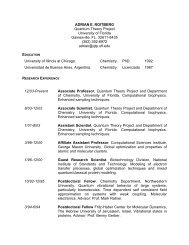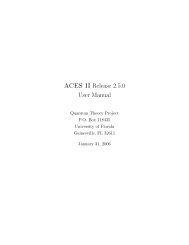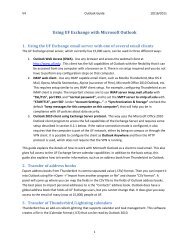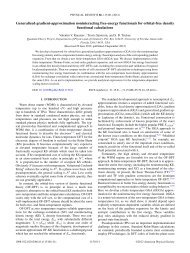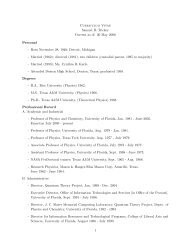ACES II User manual version 2.7.0 (PDF) - Quantum Theory Project
ACES II User manual version 2.7.0 (PDF) - Quantum Theory Project
ACES II User manual version 2.7.0 (PDF) - Quantum Theory Project
You also want an ePaper? Increase the reach of your titles
YUMPU automatically turns print PDFs into web optimized ePapers that Google loves.
5.12 intprcxintprc sorts the two-electron integrals into five basic types: OOOO, OOOV, OOVV,OVVV, and VVVV, in which O and V stand for occupied and virtual orbitals, respectively.It also calculates the MBPT(2) energy.5.13 vcc, vcc5t, and vcc5qThese programs calculate the CC energy by solving the T amplitude equations andcalculating all non-iterative contributions. xvcc also calculates finite-order perturbationtheory energies by manipulating the CC iteration logic.5.14 mrccThe xmrcc program uses a different programming environment than the rest of <strong>ACES</strong> <strong>II</strong>.This program implements many EOM-related excited-state theories like IP-EOM, DIP-EOM,STEOM, etc.5.15 fnoxfno rotates the orbitals of the reference wavefunction to frozen natural orbitals for thecorrelation corrections.5.16 lambdaxlambda solves the Λ equations to determine the response of the CC amplitudes to agiven perturbation.5.17 vea and veexvea calculates electron attachment energies by the EOM-CC method. xvee calculatesexcitation energies, transition moments, and excited state density matrices for TDA EOM-CC methods. Unlike mrcc, they both use the standard <strong>ACES</strong> <strong>II</strong> programming environment.5.18 vccehxvcceh calculates EOM-CCSD polarizability and NMR spin-spin coupling constants.5.19 densxdens calculates the one- and two-particle correlated density matrices in the MO basis.17



